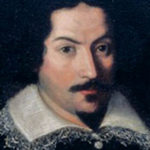Training and Early Career in Rome of Maderno
Carlo Maderno (Capolago, 1556 – Rome, January 30, 1629) was a Swiss-Italian architect, born near Lugano in Switzerland. His career is marked by the transition to the Baroque, although his early works remain influenced by late Mannerism.
He received early training in marble work, gaining expertise by working in the quarries of Carrara and Capolago. In 1576, he arrived in Rome, where he assisted his uncle Domenico Fontana, then papal architect under Sixtus V, known for his major urban planning projects and the erection of obelisks.
Under Fontana’s direction, Maderno’s initial tasks were primarily technical. He notably participated in the relocation of the Dioscuri statues to the Piazza del Quirinale and the erection of obelisks at Santa Maria Maggiore (1587), Lateran (1588), Piazza del Popolo (1589), and Saint Peter’s Square at the Vatican (1586). He also collaborated on hydraulic engineering projects, including the restoration of fountains and the management of Roman aqueducts. In 1612, he completed the Fontana dell’Acqua Paola on the Janiculum, a project initiated by Fontana, drawing inspiration from ancient fountains.
Upon the death of Sixtus V in 1590, Fontana fell out of favor and left for Naples in 1592. Maderno then took over the management of his firm.
 The Rise of an Architect: Major Commissions
The Rise of an Architect: Major Commissions
The façade of the Church of Santa Susanna, completed in 1603, marks his first independent architectural work. It is often considered a milestone of the Baroque, though it retains some Mannerist elements. Shortly thereafter, he was commissioned to build the Palazzo Mattei di Giove (1598-1618).
Under Clement VIII (pope from 1592 to 1605), he worked on the Quirinal Palace, contributing to the north façade and the inner courtyard, giving the building a sober elegance. In 1603, Maderno was appointed architect of Saint Peter’s Basilica, where he opposed the architects of the Sangallo family, whose plans for the basilica were deemed too costly or unsuitable.
After Clement VIII, he was commissioned by Paul V (pope from 1605 to 1621).
He designed the façade (completed in 1614) and extended Michelangelo’s original plan by adopting a longitudinal nave to meet the liturgical requirements of Paul V. This choice was criticized by some contemporaries, but it allowed the building to better accommodate religious ceremonies.
Maderno also designed the tomb of Paul V in Saint Peter’s (not completed during his lifetime), integrating sculpture and architecture, a project that reflects his hybrid style.
Other Achievements and Influence on the Baroque
Among his other notable projects, Maderno contributed to the construction of the Papal Palace of Castel Gandolfo under Paul V (around 1624), though his role there was limited.
He designed and began the construction of the dome of Sant’Andrea della Valle, the second largest in Rome after Saint Peter’s, completed in 1627. He was also involved in the design of the church San Giovanni dei Fiorentini from 1602, although his original plan was modified after his death. His influence is also evident in the church San Carlo ai Catinari, for which he developed the plans around 1611 before other architects finalized the construction.
On several of his projects, he trained his nephew-in-law Francesco Borromini, a future master of the Baroque. Borromini notably worked as an assistant on the Saint Peter’s project, inheriting from Maderno a technical rigor and a sense of dynamic forms, evident in his later works such as San Carlo alle Quattro Fontane.
Carlo Maderno remains a key figure in the transition from Mannerism to Baroque, contributing to the definition of a new architectural language that profoundly influenced 17th-century Roman architecture.
The Works of Carlo Maderno in Rome
- Erection of several obelisks, including the Vatican obelisk (1586), Santa Maria Maggiore (1587), Lateran (1588), and Piazza del Popolo (1589), under Fontana.
- Cappella Foscari (later Chapel Cesari) in the Basilica of Santa Maria del Popolo: restoration around 1600-1605.
- Basilica of Santa Susanna: Façade completed in 1603.
- Saint Peter’s Basilica (façade, nave): Façade (1607-1614) and longitudinal nave under Paul V.
- Palazzo Mattei di Giove (1600-1618): Built for the Mattei family.
- Church of Santa Maria della Vittoria (1608-12): Maderno began work in 1608-1612, but the church was largely completed by others (notably Bernini for the interior).
- Church of Sant’Andrea della Valle (dome): Dome designed and begun by Maderno (completed in 1627).
- Palazzo Barberini (1625, completed by Borromini and Bernini): Maderno began the project in 1625; Borromini and Bernini completed it after his death (1629).
- Quirinal Palace: Work on the north façade and inner courtyard under Clement VIII.
- Column of Peace: To be verified.
- Fountain at the north of Saint Peter’s Square: In 1613-1614, symmetrical to Fontana’s fountain.
- Fontana dell’Acqua Paola (1612): Monumental fountain on the Janiculum, completed by Maderno.
- Church of San Giovanni dei Fiorentini: Project begun Seats are still availablein 1602, central plan partially realized.
- Apostolic Palace of Castel Gandolfo: Work begun around 1624 under Paul V.
- Church of San Carlo ai Catinari: Initial design around 1611, completed posthumously.
- Tomb of Paul V (Saint Peter’s): Project designed by Maderno, not completed during his lifetime.
- Villa Aldobrandini (Frascati): Contribution to architecture and fountains (around 1600-1603).
- Church of Santa Maria della Pace: Restoration and minor works around 1610.










